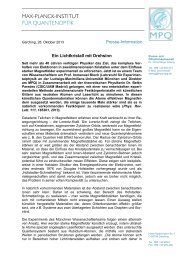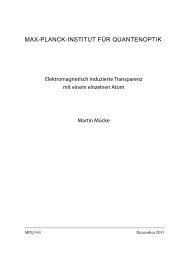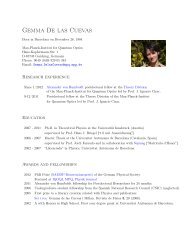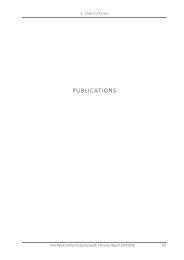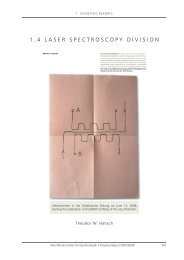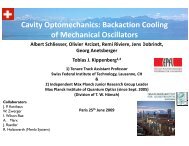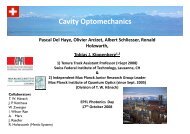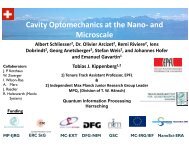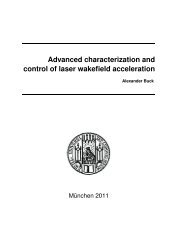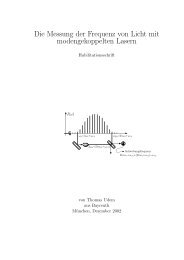Attosecond Control and Measurement: Lightwave Electronics
Attosecond Control and Measurement: Lightwave Electronics
Attosecond Control and Measurement: Lightwave Electronics
You also want an ePaper? Increase the reach of your titles
YUMPU automatically turns print PDFs into web optimized ePapers that Google loves.
1 . 3 AT T O S E C O N D A N D H I G H - F I E L D P H Y S I C S D I V I S I O N<br />
GRÜNER et al. Design considerations for table-top, laser-based VUV <strong>and</strong> X-ray free electron lasers 435<br />
tor below 1.1. Furthermore, CSR can<br />
be neglected in agreement with the 1D<br />
theory. Experimentally the most dem<strong>and</strong>ing<br />
constraint is that the Pierce<br />
parameter is one order of magnitude<br />
smaller than in the test case at 130 MeV,<br />
hence the electron (slice) energy spread<br />
should be as small as 0.1%. This goal<br />
seems to be within reach considering the<br />
bubble-transformation scenario mentioned<br />
above.<br />
Without the effect of wakefields<br />
GENESIS simulations have shown that<br />
this TT-XFEL scenario with an undulator<br />
length of only 5 m yields 8 × 10 11<br />
photons/bunch within ∼ 4 fs <strong>and</strong> 0.2%<br />
b<strong>and</strong>width, a divergence of 10 µrad, <strong>and</strong><br />
a beam size of 20 µm. However, the<br />
wakefields become the dominant degrading<br />
effect as the required undulator<br />
length is larger <strong>and</strong> the Pierce parameter<br />
reduced, hence also the tolerance with<br />
respect to variations in the electron energy.<br />
But since there is no initial spacecharge-induced<br />
energy chirp, one must<br />
find another method for compensating<br />
the wakefield-induced energy variation.<br />
A suitable method for compensating<br />
the wakefields for the TT-XFEL would<br />
be tapering, i.e., varying the undulator<br />
period along the undulator. Due to the<br />
fact that the undulator parameter K is<br />
smaller than unity, tapering via K, i.e.,<br />
by gap variation, could only be used as<br />
fine-tuning. Depending on the specific<br />
material properties of the undulator surface,<br />
our first wake calculations show<br />
that the bunch center loses over the entire<br />
5 m undulator length about 10%<br />
of its initial energy. Due to the linear<br />
wake field variation along the bunch<br />
only a fraction of it will undergo SASE.<br />
A detailed study will be further investigated<br />
in a future paper.<br />
2.3 Experimental status<br />
In order to demonstrate practical<br />
feasibility, we have built <strong>and</strong> tested<br />
a miniature focusing system <strong>and</strong> undulator<br />
consisting of permanent mag-<br />
nets. The focusing triplet consists of<br />
mini-quadrupoles with an aperture of<br />
just 5 mm, hence allowing for measured<br />
gradients of 530 T/m. Their focusing<br />
strength was measured with a 600 MeV<br />
electron beam (at Mainz Microtron facility<br />
MAMI, Mainz, Germany). A first<br />
test hybrid undulator with a period of<br />
only 5 mm <strong>and</strong> a peak magnetic field<br />
strength of ∼ 1 T has been built, <strong>and</strong><br />
produced, with a 855 MeV beam (also<br />
at MAMI), an undulator radiation spectrum<br />
as expected. These results will be<br />
published elsewhere.<br />
3 Conclusion<br />
We have shown by means<br />
of analytical estimates <strong>and</strong> SASE FEL<br />
simulations that laser-plasma accelerator-based<br />
FELs can only be operated<br />
with meter-scale undulators. The key<br />
parameter is the ultra-high electron peak<br />
current, which significantly reduces the<br />
gain length <strong>and</strong> increases the tolerance<br />
with respect to the energy spread <strong>and</strong><br />
emittance. The latter would also allow<br />
increasing of the TT-XFEL photon<br />
energy into the medically relevant<br />
range of 20–50 keV, because the limiting<br />
quantum fluctuations in the spontaneous<br />
undulator radiation, scale with<br />
γ 4 [25] <strong>and</strong> the required electron energy<br />
of the TT-XFEL is comparatively<br />
small.<br />
ACKNOWLEDGEMENTS We thank<br />
W. Decking, M. Dohlus, K. Flöttmann, T. Limberg,<br />
<strong>and</strong> J. Rossbach (all DESY) for fruitful<br />
discussions. Supported by Deutsche Forschungsgemeinschaft<br />
through the DFG-Cluster of Excellence<br />
Munich-Centre for Advanced Photonics.<br />
This work was also supported by DFG under Contract<br />
No. TR18.<br />
REFERENCES<br />
1 S.P.D. Mangles, C. Murphy, Z. Najmudin,<br />
A. Thomas, J. Collier, A. Dangor, E. Divall,<br />
P. Foster, J. Gallacher, C. Hooker,<br />
D. Jaroszynski, A. Langley, W. Mori, P. Norreys,<br />
F. Tsung, R. Viskup, B. Walton,<br />
K. Krushelnick, Nature 431, 535 (2004)<br />
164 Max-Planck-Institut für Quantenoptik • Progress Report 2007/2008<br />
2 C.G.R. Geddes, C. Toth, J. van Tilborg,<br />
E. Esarey, C. Schroeder, D. Bruhwiller,<br />
C. Nieter, J. Cary, W. Leemans, Nature 431,<br />
538 (2004)<br />
3 J. Faure, Y. Glinec, A. Pukhov, S. Kiselev,<br />
S. Gordienko, E. Lefebvre, J.-P. Rousseau,<br />
F. Burgy, V. Malka, Nature 431, 541<br />
(2004)<br />
4 W.P. Leemans, B. Nagler, A. Gonsalves,<br />
C. Toth, K. Nakamura, C. Geddes, E. Esarey,<br />
C. Schroeder, S. Hooker, Nature Phys. 2, 696<br />
(2006)<br />
5 R. Neutze, R. Wouts, D. van der Spoel,<br />
E. Weckert, J. Hajdu, Nature 406, 752<br />
(2000)<br />
6 A. Baltus, T. Udem, M. Uiberacker,<br />
M. Hentschel, E. Goulielmakis, C. Gohle,<br />
R. Holzwarth, V.S. Yakovlev, A. Scrinzi,<br />
T.W. Hänsch, F. Krausz, Nature 421, 611<br />
(2003)<br />
7 W. Thomlinson, P. Suortti, D. Chapman,<br />
Nucl. Instrum. Methods Phys. Res. A 543,<br />
288 (2005)<br />
8 A. Pukhov, J. Meyer-ter-Vehn, Appl. Phys. B<br />
74, 355 (2002)<br />
9 A. Pukhov, S. Gordienko, Philos. Trans. R.<br />
Soc. London A 364, 623 (2006)<br />
10 M. Geissler, J. Schreiber, J. Meyer-ter-Vehn,<br />
New J. Phys. 8, 186 (2006)<br />
11 D.J. Spence, A. Butler, S. Hooker, J. Opt.<br />
Soc. Am. B 20, 138 (2003)<br />
12 http://www.attoworld.de/research/PFS.html<br />
13 R. Bonifacio, C. Pellegrini, L.M. Narduci,<br />
Opt. Commun. 50, 373 (1984)<br />
14 S. Reiche, Nucl. Instrum. Methods Phys.<br />
Res. A 429, 243 (1999)<br />
15 M. Xie, Nucl. Instrum. Methods Phys. Res. A<br />
445, 59 (2000)<br />
16 Technical Design Report:<br />
http://www.hasylab.desy.de/facility/fel/vuv/<br />
ttf2_update/TESLA-FEL2002-01.pdf<br />
17 M.J. de Loos, S.B. van der Geer, Proc. 5th<br />
Eur. Part. Acc. Conf., Sitges, 1241 (1996)<br />
18 M. Dohlus, T. Limberg, Proc. FEL 2004<br />
Conf., 18-21<br />
19 G. Fubiana, J. Qiang, E. Esarey, W.P. Leemans,<br />
Phys. Rev. ST Accel. Beams 9, 064 402<br />
(2006)<br />
20 E. Saldin, E.A. Schneidmiller, M.V. Yurkov,<br />
Nucl. Instrum. Methods Phys. Res. A 417,<br />
158 (1998)<br />
21 K. Floettmann, Astra User’s Manual, 2000,<br />
http://www.desy.de/mpyflo/<br />
22 M. Ferrario, J.E. Clendenin, D.T. Palmer,<br />
J.B. Rosenzweig, L. Serafini, Proc. of the 2nd<br />
ICFA Adv. Acc. Workshop on “The Physics<br />
of High Brightness Beams”, UCLA, Nov.,<br />
1999; see also SLAC-PUB-8400<br />
23 A.W. Chao, Physics of Collective Beam Instabilities<br />
in High Energy Accelerators (Wiley,<br />
New York, 1993)<br />
24 K. Bane, SLAC-PUB-11829 (2006)<br />
25 M. S<strong>and</strong>s, Phys. Rev. 97, 470 (1955)



